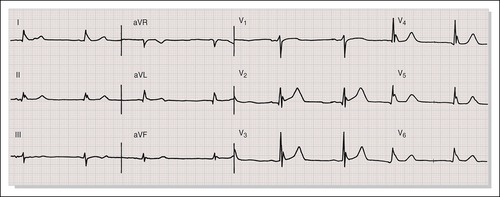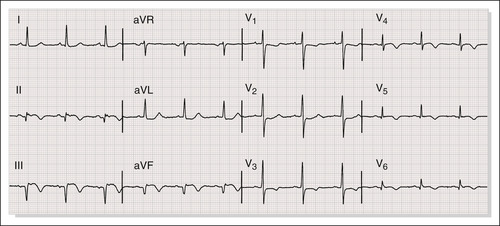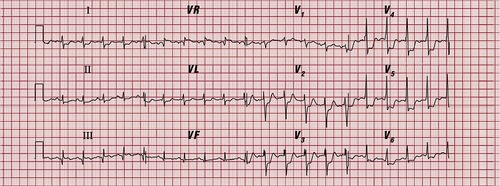CASE 28
For each scenario, answer the following questions. Give brief, relevant bullet- point answers.
28.1 Describe the changes on the ECG. What is the ECG diagnosis?
28.2 How would you manage this patient in the pre-hospital and retrieval environment?
Incident A
 |
A previously well 40-year-old male collapses in the street. The emergency services are called and immediate good-quality bystander CPR is provided. Within 5 minutes, a land ambulance arrives, diagnoses ventricular fibrillation and provides advanced life support. The PHR team arrives a few minutes later and, after the fourth shock, spontaneous respiratory effort is noted. The pulse is now easily palpable but the patient remains unconscious and the rhythm strip above is recorded. The patient is intubated and ventilated and has received 1mg of adrenaline and 300 mg of amiodarone through an intravenous cannula.
Incident B
 |
Incident C
 |
The PHR team has been tasked to a rural single-doctor clinic, where a 50-year-old male has been complaining of indigestion for the last 45 minutes. He has had several similar but less severe attacks over the previous 2 weeks, which resolved spontaneously. He is a smoker and has non-insulin-dependent diabetes controlled on oral medication. He complains of associated nausea. On examination, he is pale and diaphoretic. His heart rate is 75 beats per minute, BP 90/50 mmHg and blood glucose 12 mmol/L. The above 12-lead ECG has been recorded by the clinic doctor.
Incident D
 |
A 62-year-old female with chest pain and breathing difficulties has called an ambulance. The PHR team is located a few minutes from the scene and agrees to attend. The patient has a previous history of angina and is lying on the sofa complaining of central crushing chest pain resistant to glyceral trinitrate spray. Her heart rate is 120 beats per minute, BP 165/105 mmHg and SaO2 92% on air. The PHR team records the above 12-lead ECG.
Discussion
Incident A
1. The ECG shows regular, broad complex tachycardia. Monomorphic with retrograde P waves. Diagnosis: Monomorphic ventricular tachycardia.
2. Important steps in managing this patient in the pre-hospital environment include:
• Ensure scene safety.
• Check vital signs and confirm placement of tracheal tube.
< div class='tao-gold-member'>
Only gold members can continue reading. Log In or Register to continue
Stay updated, free articles. Join our Telegram channel

Full access? Get Clinical Tree







